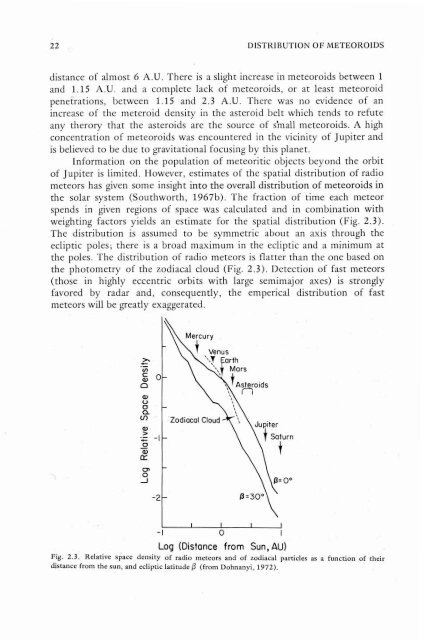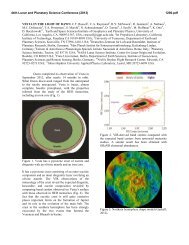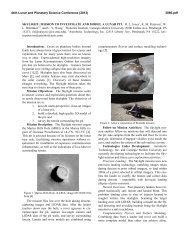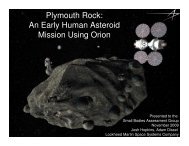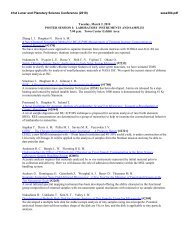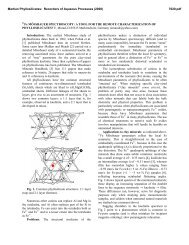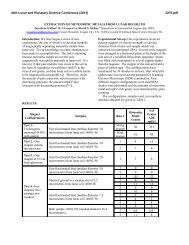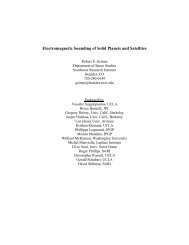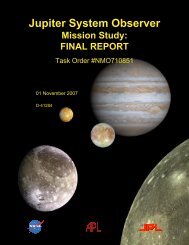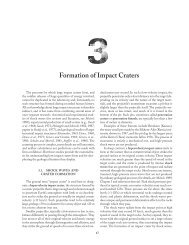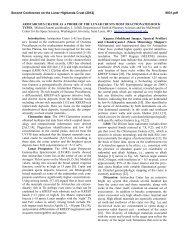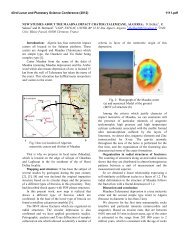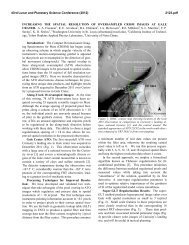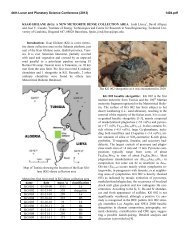Chapter 2: Energy at the Lunar Surface - Lunar and Planetary Institute
Chapter 2: Energy at the Lunar Surface - Lunar and Planetary Institute
Chapter 2: Energy at the Lunar Surface - Lunar and Planetary Institute
You also want an ePaper? Increase the reach of your titles
YUMPU automatically turns print PDFs into web optimized ePapers that Google loves.
22 DISTRIBUTION OF METEOROIDS<br />
distance of almost 6 A.U. There is a slight increase in meteoroids between 1<br />
<strong>and</strong> 1.15 A.U. <strong>and</strong> a complete lack of meteoroids, or <strong>at</strong> least meteoroid<br />
penetr<strong>at</strong>ions, between 1.15 <strong>and</strong> 2.3 A.U. There was no evidence of an<br />
increase of <strong>the</strong> meteroid density in <strong>the</strong> asteroid belt which tends to refute<br />
any <strong>the</strong>rory th<strong>at</strong> <strong>the</strong> asteroids are <strong>the</strong> source of s'mall meteoroids. A high<br />
concentr<strong>at</strong>ion of meteoroids was encountered in <strong>the</strong> vicinity of Jupiter <strong>and</strong><br />
is believed to be due to gravit<strong>at</strong>ional focusing by this planet.<br />
Inform<strong>at</strong>ion on <strong>the</strong> popul<strong>at</strong>ion of meteoritic objects beyond <strong>the</strong> orbit<br />
of Jupiter is limited. However, estim<strong>at</strong>es of <strong>the</strong> sp<strong>at</strong>ial distribution of radio<br />
meteors has given some insight into <strong>the</strong> overall distribution of meteoroids in<br />
<strong>the</strong> solar system (Southworth, 1967b). The fraction of time each meteor<br />
spends in given regions of space was calcul<strong>at</strong>ed <strong>and</strong> in combin<strong>at</strong>ion with<br />
weighting factors yields an estim<strong>at</strong>e for <strong>the</strong> sp<strong>at</strong>ial distribution (Fig. 2.3).<br />
The distribution is assumed to be symmetric about an axis through <strong>the</strong><br />
ecliptic poles; <strong>the</strong>re is a broad maximum in <strong>the</strong> ecliptic <strong>and</strong> a minimum <strong>at</strong><br />
<strong>the</strong> poles. The distribution of radio meteors is fl<strong>at</strong>ter than <strong>the</strong> one based on<br />
<strong>the</strong> photometry of <strong>the</strong> zodiacal cloud (Fig. 2.3). Detection of fast meteors<br />
(those in highly eccentric orbits with large semimajor axes) is strongly<br />
favored by radar <strong>and</strong>, consequently, <strong>the</strong> emperical distribution of fast<br />
meteors will be gre<strong>at</strong>ly exagger<strong>at</strong>ed.<br />
-I 0 I<br />
Log (Distance from Sun, Au)<br />
Fig. 2.3. Rel<strong>at</strong>ive space densi'ty of radio meteors <strong>and</strong> of zodiacal particles as a function of <strong>the</strong>ir<br />
distance from <strong>the</strong> sun, <strong>and</strong> ecliptic l<strong>at</strong>itude 0 (from Dohnanyi, 1972).


